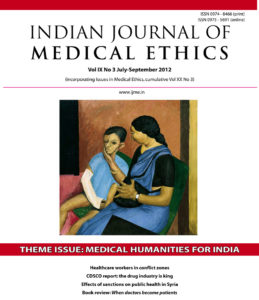
The recent focus in the media has been on doctors involved in varieties of wrongdoing: sex determination tests and illegal abortions, illegal clinical trials on innocent patients, allowing untrained attendants to do their work criminal negligence in the disposal of medical waste, and the list goes on. Can healthcare professionals argue that they are no different from others in an increasingly corrupt society? No, they are expected to be dedicated, caring, and trustworthy,no matter what social environment they live in. It is an occupational hazard,based on the simple fact that medicine is a matter of life and death.
The guilty must be punished. However, the challenge is to nurture ethical values in members of the profession. One approach is to introduce the medical humanities into medical education, to open up the mind to imagination and empathy, to enable one to enter the skin of the “other”, the patient, and feel as she or he feels. This issue of IJME has medical humanities as its theme and its vital importance is explored from the viewpoints of students, clinicians and teachers, and coordinated by our guest editor, Radha Ramaswamy.
Other articles in this issue cover a range of subjects. Public health professionals report on the devastation caused by sanctions in Syria. An editorial tackles the deaths of healthcare workers caught in the cross fire between opposing forces in war zones. Two studies look at the critical question of informed consent, one among patients in a service-oriented hospital and the other among nurses participating in a study, and finds lacunae in both settings. Another study explores the inclination of nurses to support their patients, even from neglect by other care givers, and asserts that institutions must support nurses who advocate for their patients. A comment refutes the charges against a doctor as false, challenging the tarnishing of a reputation based on insufficient investigation. Others analyse the inevitable compromises made while framing mental health laws, or when letting go at the end of life.
Cover image: Original painting “Clinic” by kind courtesy of the artist Dr Sudhir Patwardhan
